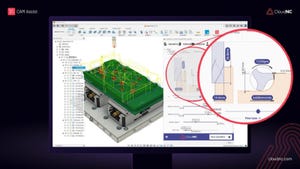Retrofits for Aging Extrusion Lines
September 22, 2010

At 30 years old and approximately 75-ft long, theBlack-Clawson two-station extrusion laminator that dominates the Amgraphproduction floor has made the switch from analog drives and drifting systemvariables to a modern all-digital system.
As customer requirements surpassed the capabilities ofthe existing system, Amgraph faced several choices for supplying flexiblepackaging solutions for the food industry. It could spend millions on a newmachine, settle for lower productivity and product diversity, or retrofit theequipment with modern controls. Amgraph opted to replace its analog controlsystem with high-efficiency motors, digital drives and updated controls.
Asa result, Amgraph now produces a wider variety of coated plastic and foilflexible food packages, was able to cut material expenditures and improvethroughput, and boost productivity.
DSC_0006-1_A |
Tension Control
Circonix, a Siemenssystem integrator and solutions partner that specializes in web handling applications, was contractedby Amgraph to redesign its packaging machine's automation system.
"Initially,the machine had four different motors with analog drives and controls, eachwith their own wiring harness and relay logic, which really made the machines achallenge to maintain," says Andrew Alaya, vice president of engineering forCirconix. "Only one of the sections was capable of tension control, whichforced Amgraph to operate the extrusion machine in draw mode. This meant thatthe machine could only handle certain types of coatings without breaking theweb and going down. Improving that uptime through better tension control wasthe main goal of the project."
Circonixengineers decided to retrofit the extruder's four existing analog drives withSiemens motors and Sinamics S120 drives, while adding four load cells inlineand a new Fulton Machinery dancer to the machine's two unwind spindles. TwoVetaphone treaters were also added inline as part of the retrofit. Theseeffectively eliminated the need for the primer coater, and served as pullstations for the machine, also now driven by Siemens motors and drives. Thesemodifications allowed the machine to work in closed-loop tension control mode.
Bychanging values on the HMI and PLC (provided by Wonderware and RockwellAutomation, respectively), Amgraph can now precisely control the speed andthickness of the web, turn various systems such as treaters, laminators andtension control systems on or off, and apply thinner coatings to packagematerials without worrying about additional web breaks and downtime, or thickercoatings to meet special customer needs.
DSC_0012_B |
"Nowthat we have more control of the system, we're looking at replacing the thickerfilms that we used to purchase from other vendors with extruded materials wemake ourselves, which saves us money," says David Rand, production manager atAmgraph. "Our initial trials have been successful."
Thenew motors, upgraded digital drives and new controls also increased theextrusion machine's uptime, throughput and productivity. The high bandwidth ofthe Sinamics S120 digital drives allows for improved speed regulation andfaster response, both of which are key to improving tension control. Amgraphset aggressive goals of 95 percent uptime for the retrofitted extrusionmachine.
Inaddition to increasing uptime and the number of products the machine canhandle, Rand says the retrofit has increased throughput up to 20 percent,depending on the product line. "We've definitely increased production speeds,"he says. "We're happy where we are now, but we still have opportunities toimprove throughput."
Addressing Retrofit Concerns
Theprimary issues with the original system centered on the analog drive system andsystem variables that drifted, so the challenge was moving to an all-digitalsystem. Sections of the older system used draw control, developed by using thespeed differential from one section to another, rather than direct tensioncontrol on the individual axes.
Loadcells for direct tension control were added to sections that originally useddraw control, and the final configuration provided an ability to use eitherdraw or tension control. This is important when you have an extensible web,because it is easier to use draw control and a speed ratio to develop tensionon the material. But if the web doesn't have modulus in it, the resolution ofthe speed differential becomes more critical. If the accuracy of the drive,which provides speed regulation, is not as good, that also complicates theapplication.
Induction motors were used for the application, with thedrives providing an ability to run in a servo mode. On several convertingapplications (due to torque requirements), many engineers still usehigh-performance induction motors. The drive offers a servo mode whichincreases dynamic performance to reduce motor current more quickly and provideoptimized performance with a standard NEMA induction motor in the 30 to 40 hprange.
Retrofitting large production machinery like theBlack-Clawson extrusion laminator machine rarely progress as scheduled, becausechanging a machine from discrete analog to digital control systems with thelatest energy-saving ac induction motors presents significant electronic andmechanical engineering challenges.
Customers also typically want to use specific equipmentproviders for certain systems. In this case, Amgraph specified a third-partyHMI and PLC technology, which meant Circonix needed to interface the SinamicsS120 drives with third-party systems. Using Siemens' Starter drive engineeringand commissioning software, and integrating the Sinamics S120 drives using theelectronic nameplate capabilities of Drive-Cliq for motor and drive components,the project was able to be delivered to Amgraph on time and within budget.
"We used Profibus to tie the drives together and an SSTmodule in the PLC to talk to the Siemens drives," Alaya explains. "With theSiemens dc bus lineup, all the drives fit in a single cabinet that was smallerthan the space of one of the previous motor control systems. We were able toeliminate the wiring mess and relay logic that came with the older analogcontrols as well, which significantly simplified maintenance andtroubleshooting for the customer while improving performance and uptime."
About the Author(s)
You May Also Like






.jpg?width=300&auto=webp&quality=80&disable=upscale)

